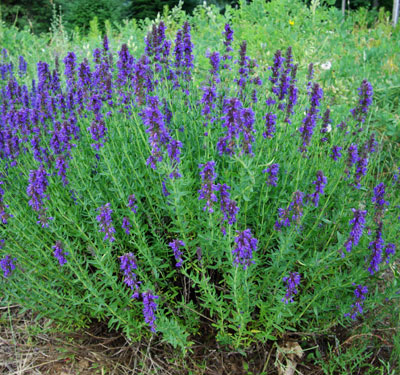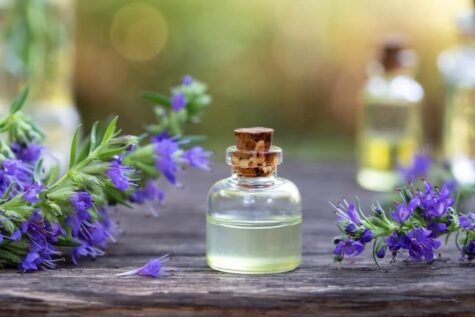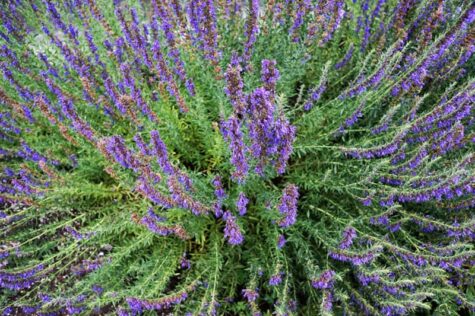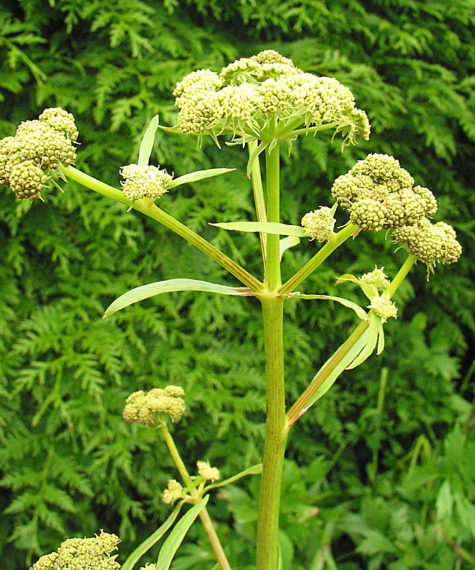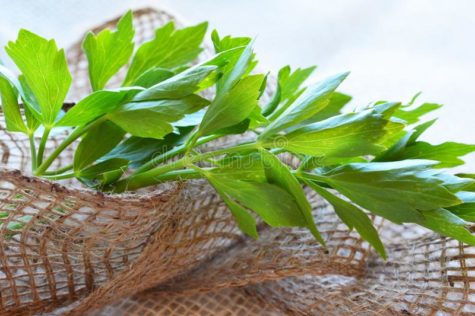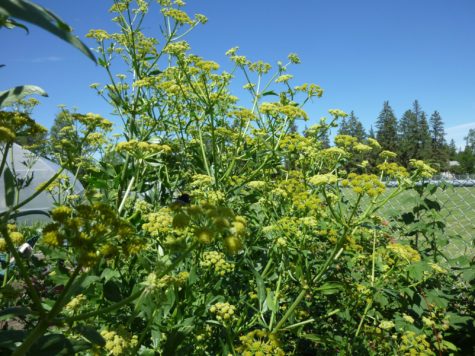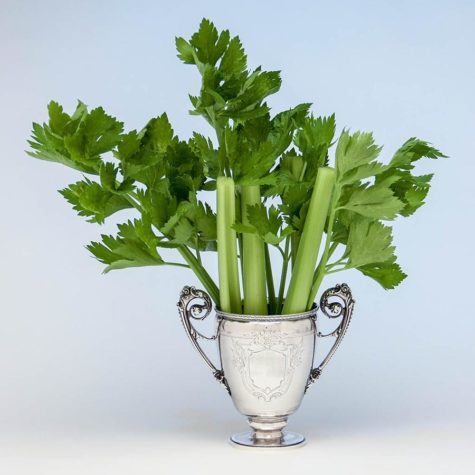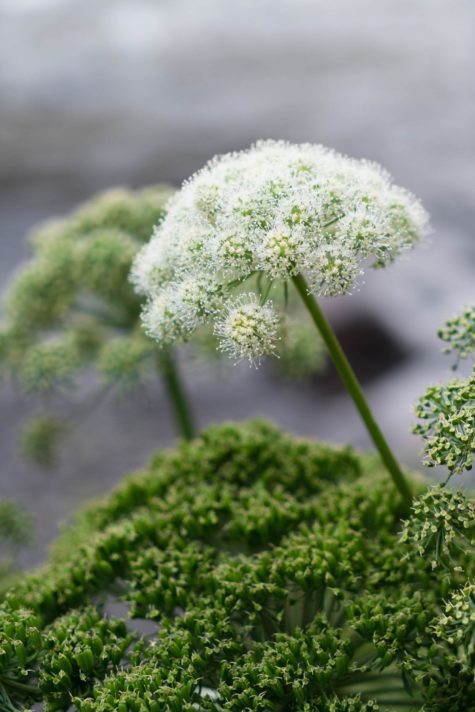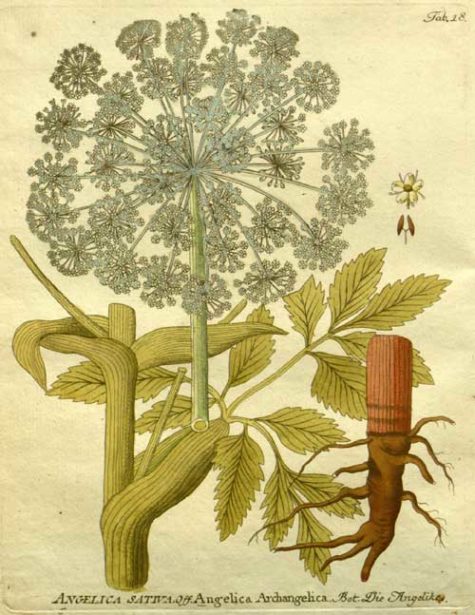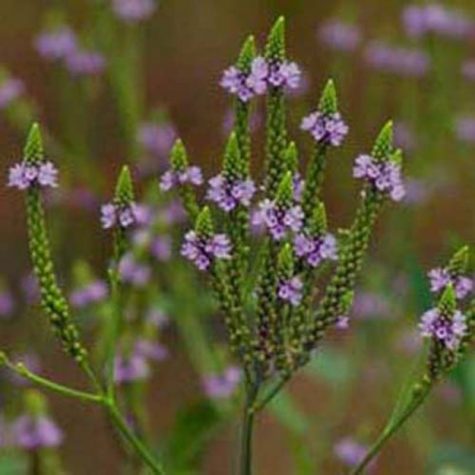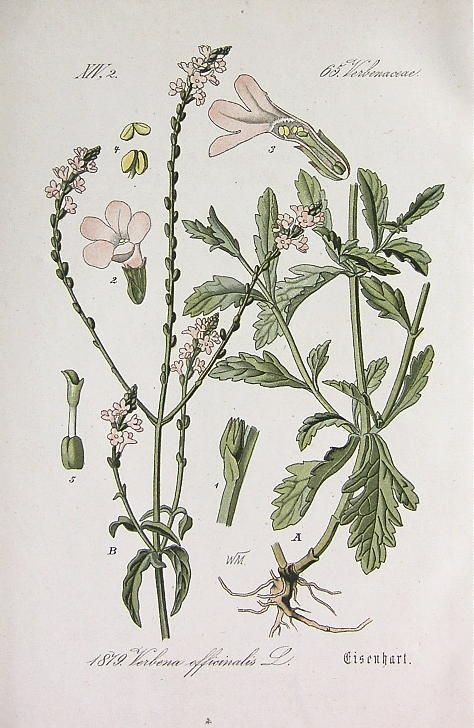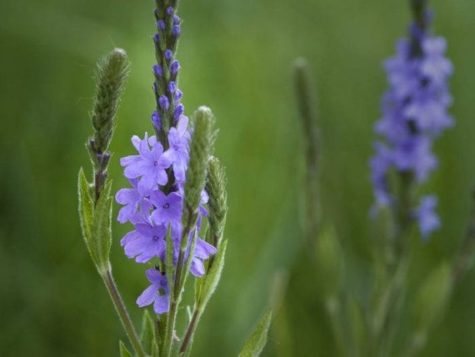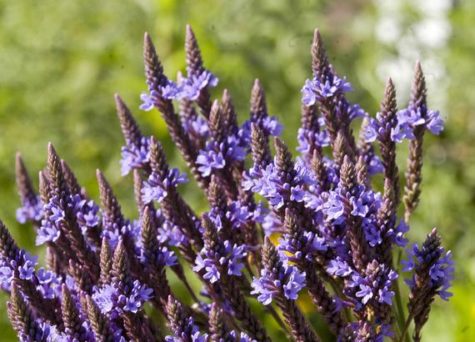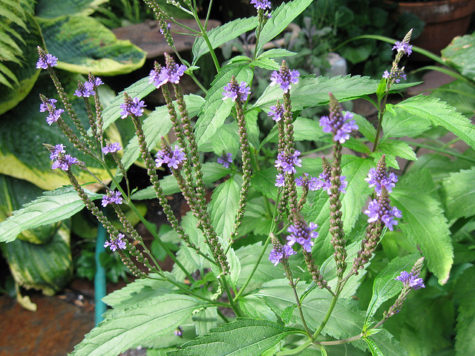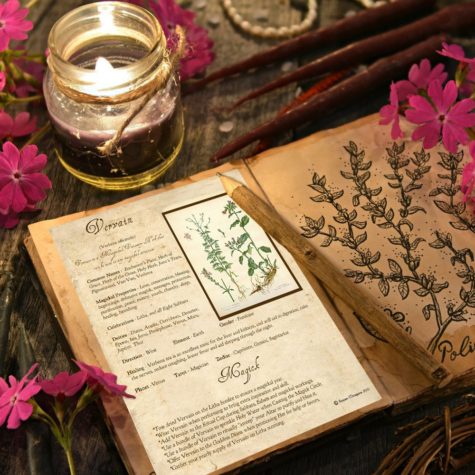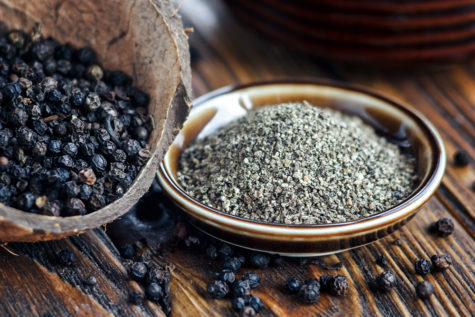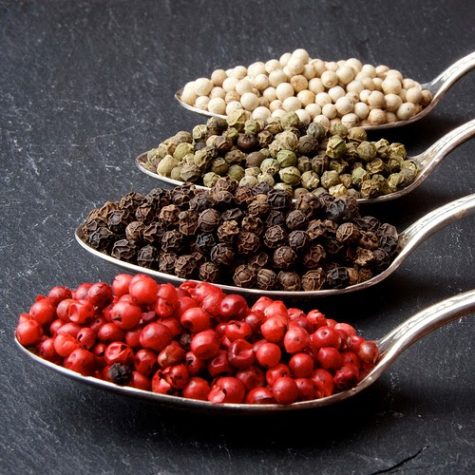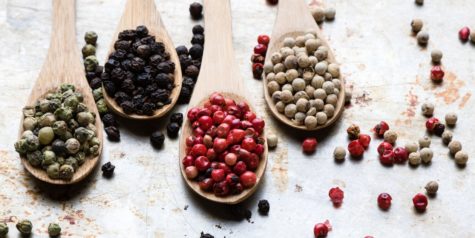Herbs and Spices
- Ruler: Jupiter
- Element: Fire
- Type: Plant
- Magickal Form: Dried leaves, Essential oil
- Magickal Influences: Purification, Conscious mind
Hyssop, (Hyssopus officinalis) is the herb that purifies your life. This magickal herb will protect you and your home, purify your altar or sacred space, and dispel depression. In the language of flowers, hyssop flower meaning is traditionally symbolic of humility, repentance, health, and sacrifice.
Hyssop has long been used in ritual. Temples in ancient Greece were swept with bunches of this herb. Hyssop was deemed to be sacred to the Goddesses and the Gods.
The Bible calls Hyssop the herb of forgiveness. It is mentioned in Psalm 51, “Purge me with Hyssop; wash me and I shall be whiter than snow.” It was used over six thousand years ago in guilt offerings.
Add a pinch of dried Hyssop to your bathwater as part of a ritual of healing and purification, especially if you have been feeling depressed. This will also help to alleviate feelings of guilt.
Hyssop is a serious karmic herb and can be used to heal the world of negativity. Sprinkle upon the earth for world peace. To remove negativity in your home, tie a bunch of hyssop branches together to create a symbolic broom. Then use it to sweep your home, removing any negative energy or spirits.
You can also use a small bunch of Hyssop leaves to sprinkle water over objects or around rooms to bless them. Hyssop grown around the home is said to repel thieves.
Hyssop is said to have gone into the making of Solomon’s Sprinkler, and is the best choice of herbs to day to make a sprinkler for holy water. Here’s how to make one:
Gather Hyssop beneath the New Moon in Cancer, and dry it through the Full Moon (although it may take longer than this to be completely dry). The handle may be fashioned of wood, or a binding of leather wrapped around it. As such, it will cleanse your magickal space and make it sacred for ritual.
When the plagues visited Egypt, the Hebrew people made brushes of dried bunches of Hyssop. These were used to paint the portals with blood, which protected their children until the priest Moses would lead them away.
Place bunches of hyssop over doors, windows, and room thresholds to prevent entry of infectious disease. Carry small hyssop bouquets when venturing out during flu season (or a pandemic).
Inhale the sharp, greenly-scented essential oils for purification. Or, sniff sprigs of the fresh herb. Place hyssop in a vase of water and leave in the home to purify it as well. The scent of fresh hyssop will clear your head and strengthen your mental processes.
You can also add about a half a cup of Hyssop tea to your mop water to cleanse your house To make the tea, add two tablespoons of dried Hyssop to two cups of boiling water and allow the mixture to steep for about ten minutes before straining it. You can empower this cleansing by reciting Psalm 51 as you mop. Dispose of the used wash water at a crossroads.
Hyssop in olive oil can be added to the bath to kill jinxes and for relief from sin. To kill a jinx, rub the oil mixture downward while standing between two white candles in the bath, as you cleanse yourself recite the 21st Psalm. Carry the used bath water to a crossroads and throw it toward sunrise, saying: “In the name of the Father, Son, and Holy Ghost.” This can also be used to cleanse yourself after practicing dark magick.
Because of its associations with religion, the scent of fresh hyssop can be sniffed to heighten spirituality prior to religious rituals of all kinds. Since it is also a holy herb, you may drink Hyssop as a tea to deepen your connection to the divine.
When burned as incense, dried Hyssop will raise the spiritual vibrations of your home and release the energy of protection.
Hyssop is associated with dragons and it is said that burning it will assist your interactions with them.
Hyssop does have some affinity with the winter solstice and as such can be used in combination with holly. Small bunches of hyssop and holly can be gathered in the summer, bound up with a suitable colored cord, and hung around the home to guard and protect the abode and all who dwell within it.
Hyssop essential oil is excellent for cleansing auras and for healing by the laying on of hands. It is also good for consecrating magickal tools which are of tin, and is the herb for cleansing amethyst and lapis lazuli.
Warnings:
Hyssop essential oil is a highly potent form of this herb. It is toxic in large doses. In children, very low doses can cause convulsions. It’s possible that this may be the only essential oil capable of producing true epileptic seizures. For safety, substitute the fresh herb.
Hyssop should not be taken by people with epilepsy or any history of seizures. Hyssop should not be used while pregnant (may cause miscarriage) or breastfeeding (just to be safe). Small amounts of hyssop used in seasoning foods are considered safe.
Sources:
- Complete Illustrated Encyclopedia of Magical Plants
- Encyclopedia of Magickal Ingredients
- Hoodoo Herb and Root Magic
Magickal Uses
- Planet: Sun, Venus
- Ruler: Pan, Astarte
- Element: Water, Fire
- Astrological Sign: Taurus
- Parts Used: Dried Root
- Basic Powers: Love, Purification
Lovage is one of the most dependable herbs for drawing romance into one’s life. Not only will it bring you love, but regular bathing with this herb will enhance your beauty, physically, and will also allow the inner radiance to shine forth more brightly.
For this reason, Lovage is often used as a bathing herb, cast into the bath, the pleasant scent filling the room and delicately scenting the bather. In this manner, particularly when combined with a candle and poems of a romantic nature, is one able to attract romance.
Add seven rose buds to a Lovage bath, and you will become more attractive to the opposite sex.
With a subtle floral scent, the root is an effective addition to Herbal Amulets to attract love, and it can be steeped in wine to be served to a prospective lover.
You can also add the root, or a strong tea made by boiling the root, to a bath to become psychically cleansed.
In Central Europe, women wore Lovage around their necks when meeting lovers, and the herb was often put in love potions as a guarantee of everlasting devotion.
To encourage someone to love you more, the following can be done:
For nine successive days, rise early, boil Lovage root in water to make a tea, hand-bathe your genitals and face in this before dawn, carry the wash basin to a crossroads, call the name of the one you love, and throw your used bath water toward the sunrise.
One of the most nonjudgmental of herbs, Lovage draws the person most suited to your soul. A great root for bisexuals or anyone confused about which gender he or she is (or should be) attracted to. It is best used when invoking a new relationship and promises to quickly attract your heart’s desire.
Plant Lovage in front of and around your home to help ward off all sorts of unwanted intruders, ranging from door-to-door salespeople, to evil spirits, to epidemics, to vermin.
The leaves can be placed in the shoes to relieve weary feet.
Lovage dug up at night on Good Friday reputedly helps ward off either witches or the influence of the Devil.
Folk Names
- Bo’ Hog Root
- Gout Weed
- Italian Parsley
- Lavose
- Love Root
- Lubestico
- Sea Parsley
- Smellage
History and Folklore
The history of Lovage goes back to the ancient Greeks who chewed the leaves for digestion and gas. Both the Greeks and the Romans used the herb as a medicine, and in the Middle Ages it was used as a cure-all for most illnesses.
- The seeds were nearly as expensive as black pepper at one time.
- Hildegard of Bingen used Lovage in her cooking.
- John Gerard believed Lovage was one of the best remedies of his time (mid 1500s).
Lovage has an ancient history. It was introduced into Britain by the Romans and brought here by early English colonists and was often found in their gardens. Lovage was one of the seeds found in the early American Shakers’ seed sales.
As both a medicinal and culinary herb, Lovage now grows in the authentic garden at Plimoth Plantation, the re‐creation of a Pilgrim village in Plymouth, Mass.
New Englanders would candy the root and chew on the seed during long church services to keep them alert.
Colonial women “cured” many ailments with Lovage: sore eyes, upset stomach. They used fresh leaves for summer “sallets” and flavored winter soups, with the dried root. The dried leaves seasoned the stuffing for roast goose or turkey.
Sources:
- Encyclopedia of Herbology
- The Master Book of Herbalism
- The Herb Book by John Lust
- The Complete Book of Herbs and Spices
- Hoodoo Herb and Root Magic
- Magical Herbalism
- The Herbal Academy
- The Herbal Alchemists Handbook
- Element Encyclopedia of 5000 Spells
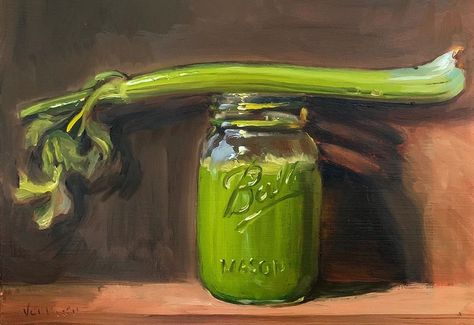
Magickal Uses
- Ruler: Mercury
- Element: Air
- Parts Used: Seed, Stalks, Oil
- Magickal Influences: Psychic awareness, Sleep
It should be mentioned that this is the garden celery under the rulership of Mercury, rather than Wild Celery, which is under the dominion of Venus.
This herbal seed, found in most kitchens, is used as a Visionary Herb. There are forms of divination which recommend drinking a tea of the seed as it opens the mind and allows for better concentration.
Use celery seed to increase male virility. Men can either eat it or add it to poppets in sympathetic magick spells.
To awaken your psychic awareness, crush about a teaspoon of the dried seeds and tie up in a piece of thin, cotton cloth. Inhale the odor and visualize your conscious mind relaxing (perhaps as a fist relaxes), allowing true communication with your psychic mind to occur.
- Rub the oil into fingers or the third eye to increase communication skills.
- Eat raw celery to remove blocks and fears and to promote weight loss.
- Cook the stalks in soup for love.
Folklore recommends putting celery into an herb pillow to induce sleep. Chewing celery seeds reportedly enhances concentration. Or burn them with orris root (iris roots) to enhance psychic powers. Witches flying on their brooms chewed celery seed to prevent dizziness.
Celery is sometimes used as a cure for impotence. Several sticks of celery need to be boiled in a saucepan of water until the celery turns into a pulp. The person with the problem needs to eat this while it is still hot, and can then look forward to a night of successful lovemaking.
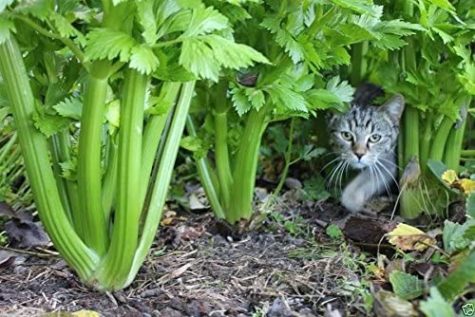
Folk and Other Names
- Aches des Marais
- Ajmoda
- Ajwan
- Apii Frutus
- Apio
- Céleri
- Celeriac
- Fruit de Celeri
- Graine de Céleri
- Karmauli
- Maiden’s Smallage
- Persil des Marais
- Qin Cai
- Smallage
- Selleriefruchte
- Selleriesamen
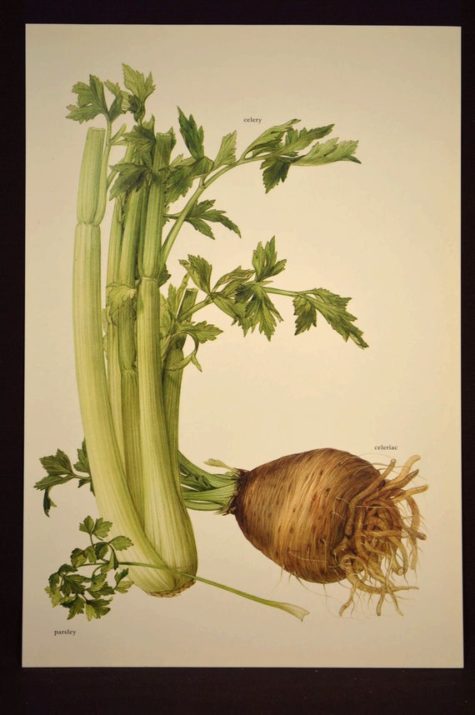
Folklore and History
Celery had its beginning several thousand years ago in shallow swampy areas of mainland China. The plant was prized for its seed, used medicinally and as a flavoring, and mentioned in the writings of Confucius. This would place it at about 500 B.C. on the world timeline.
A similar plant grew in the Mediterranean. It had a strong aroma (its Latin name means “strongly smelling”) and dark green leaves. The Greeks fashioned wreaths from it to adorn the victors in athletic and musical competitions. The Romans considered deemed it an aphrodisiac. And garlands of the leaves were found in Tutankhamun’s tomb.
The modern name “celery” comes from Greek selinon. It was ascribed to Silenus (or Seilenus), the son of a nymph and lustful Pan (or, according to other depictions, Hermes, the messenger of the gods who transgresses all borders).
Silenus, constantly drunk and lecherous, is depicted as pot-bellied with a beefy bald head and often with the ears, tail, and legs of a horse. He was the leader of the lustful horde of satyrs as well as the teacher and companion of Dionysus, the god of inebriation. Half human, half horse, Dionysus symbolizes, among other things, the powerful animal drive. The association of this satyr with celery, emphasizes the plant’s use as an effective agent of sexual potency.
Celery is presented as signifying both death and sensual pleasures in Homer’s epic The Odyssey: celery grows among violets in the meadows on Calypso’s magical island. (The Hellenes classified violets as “erotic plants,” which they dedicated to Priapus, the little deity with the big phallus; Aphrodite, the goddess of love; and Persephone, the goddess of the underworld and the dead.)
In the Odyssey, the enchantress Calypso took in shipwrecked Odysseus and held him enraptured for seven years; she also turned his men into “swine.” Comparative religion studies indicate that Calypso was a goddess of death, as the name suggests (kalypto = to enshroud) and that pigs were sacred to the earth and death goddess of antiquity.
That Odysseus ultimately freed himself from her magic is seen as a victory over death, as in all mythologies the hero, having come dangerously close to death, succeeds in wresting new life from the dark forces. This interpretation lends meaning to the ancient Greek practice of crowning winners of riding and gymnastic games with celery leaves.
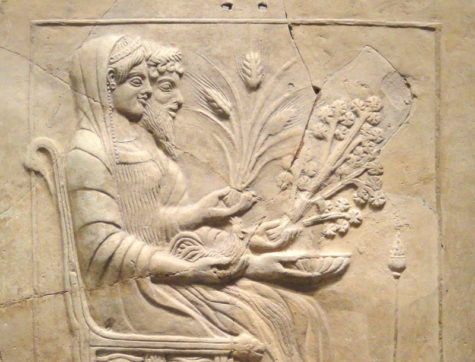
Celery has a long association with death. Ancient Egyptian mummies were often decorated with celery and blue lotus blossoms. Ancient Greeks planted it on graves and used it to season funeral feasts. The Roman Virgil (70–19 BC) described much the same:
“Godly Linus decorated his head with flowers and bitter celery [as a sign of mourning]”
“It is not right to put celery in common dishes because it belongs to funeral feasts.”
The Romans also dedicated celery, as part of the death rites, to Orcus, the god of the underworld, as told by Plutarch (45–120 AD): “We decorate our gravesites with celery.” Given such practices, it was considered a bad omen to see a cart loaded with celery first thing in the morning. And for someone who was marked by death, the Romans said: “There is only celery left for him.” This is an interesting angle given the fact that, like the ancient Greeks, Romans also crowned their victors with celery leaves. And celery, next to dill and coriander, was a favorite condiment in the Roman cuisine.
Celery’s association with death lasted well into our own times. Wend (Slavic) tradition in northern German Spreewald claims that merek (celery) protects against being haunted by the dead.
And the Italian fairy tale “Marianne and the Celery King” tells of a maiden who, attempting to pull a celery bulb from the soil is instead pulled into the ground; “the ground closed over them like water over a stone.” Below the earth, she finds a golden castle and an old, long-bearded hunchbacked man who resembles a celery root: the Celery King, who marries and impregnates her. But he is also an enchanted prince. After the heroine surmounts numerous tasks and challenges she is able to redeem the prince and bring him back to the world above the ground.
Nowadays such stories are given anecdotic value at most. However, traditional customs, folklore, and imaginative perception teach us much about the essence of the plant. In such imaginative terms, let us consider the celery.
Celery is a biennial; its “incarnation” lasts two years. In the first year, it concentrates on absorbing salty, moist earth forces, during which time it swells and becomes lush. During this year there is a clear pull to the dark, cool earth realm, to downward-moving elements and, figuratively speaking, to the grave, bitter death, and the mourning that causes salty tears to flow—but also to the fertile, ever-bearing primal source.
In the second year the plant ascends to the light, shooting up into bloom, opening and branching out as it bathes in cosmic light. The plant now sets a counterpoint to the earthy, moist, salty forces with its “light and fiery” essential oils.
Thus it becomes a plant for victors and heroes, one that overcomes the dark forces, that wards off the evil eye (in Spain), that thwarts the scheming of wicked witches. Even in modern Greece celery blossoms—together with garlic and onion—are hung for good luck. They protect the area where silk worms are being raised; small children are given amulets of celery to keep them from harm.
In Prussia and Pomerania the leaves were stuffed into cracks in floors and walls in pigsties to protect the animals from evil magic—and young married couples were given a piece of root to put in a pocket or a shoe for good luck.
Nicholas Culpeper (1616–1654) recognized the ambivalent nature of celery. He ascribed the plant to the hermaphroditic god, Mercury—the Roman Hermes, who can as easily fly up to the light-filled world of the gods as he can descend to the underworld. Indeed, Mercury-Hermes is the ruler of rising and sinking energy flow. He loosens, cleanses, opens, splits, and removes blockages by bringing everything back into flow.
Culpeper, just as other doctors before and after him, used this mercurial plant to heal “water diseases,” “obstructions” while urinating, and stone ailments, and to activate the liver and the spleen.
Celery works in the microcosm of the human body true to character. It affects the root chakra, the Muladhara, down into the sexual organs and the “salty, watery” urinary organs. Celery can reduce the milk flow for nursing mothers—a compress can actually temporarily reduce the breast size—but can also stimulate the uterus and bring on menstruation.

As “maiden’s smallage” it belonged to the herbs that women took in case of a “belated period,” when they feared they’d been impregnated. German scholar and bishop Albertus Magnus (1200–1280) described the downward pull of the plant: “Celery causes sensual desire to descend from the breasts of wet nurses to the genital area and bring about menstruation.”
It is often the case that emmenagogues work for men as aphrodisiacs, as indicated in such names as “stand-up herb” (Lausitz, Germany), “stand-up wort,” “stud wort” and “buck’s wort.” A fifteenth-century medical book tells us: “So that your wife stays faithful forever mix celery juice and honey and rub your genitals with the mixture. This way she will be satisfied and will want no one else but you.” Consider too this German saying:
Fry me eggs, sweetheart,
with celery and lettuce,
on Sunday we will go courting,
my mother told me this.
This aspect of celery is also well known in France, the country of savoir vivre and l’amour, as in the following: “If a woman knew what celery does to a man, she would be willing to go from Paris to Rome to find it.” And, “If a man knew what celery does for him, he would plant his garden full of it.”
In 14th-century Italy where the rich and curious began to selectively cultivate celery. The stalks became fatter and pleasingly crunchy; they paled from intense dark green to a subtle, delicate hue; and the taste evolved from bitter to pleasingly grassy and citrus-like.
When celery lost its flavorful wild side, it also became less rampant. These new strains were fussy and difficult to obtain, which of course made them irresistible to the elite. By the mid-19th century, celery was so prized by the upper class that serving vases were made specifically for the purpose of displaying it as the centerpiece at fine dinners.
While European epicures were feasting on blanched celery au velouté, American farmers were reveling in how easy it was to cultivate the luxury vegetable in the Great Lakes region. They were resourceful, ambitious, and even competitive when it came to growing celery.
As the celery craze was reaching its zenith in the 1870s, Dutch farmers who knew how to handle wetlands began growing the vegetable in the black, marshy soils of Kalamazoo, Michigan, which became known by the catchy name the Celery City. The streets were littered with hucksters peddling celery from street corners and train stations. As American cultivation improved, celery became an everyman’s item. By then, the British upper classes had moved on to French luxuries like truffles and oysters.
Sources:
- Magickal Aromatherapy by Scott Cunningham
- Publicism
- Encyclopedia of Magickal Ingredients
- Encyclopedia of Herbology
Folk Names:
- Angel Food
- Archangel
- Garden Angelica
- Masterwort
- Root of the Holy Ghost
Magickal Uses:
Angelica (Angelica archangelica) is known in magickal herbalism as a powerful guardian and healer. It is said to banish negativity and attract positive energy. Angelica grows in tall, blossoming stalks—but typically only the root portion is used in spellwork. It is said to enhance female power, protect children, ward off evil, and improve health and family matters.
Angelica means angelic and in the places where it grows, it has been revered as a special plant. In Scandanavia, it was used as a shamanic medicine by the indigenous Sami people. In the U.S., various varieties of Angelica were used in rituals and ceremonies by Native American tribes. The Iroquois brewed Angelica root into a tea and sprinkled it about their homes to quiet “rattling” ghosts.
Angelica’s magickal virtues are linked to its robust stature, pleasant aroma, and association with the Archangel Michael. Legend has it that the angel appeared in a dream to a monk, showing him the herb that could cure the plague in Europe. Traditionally, Angelica blooms on the feast of the Apparition of the Archangel Michael, May 8.
Ruled by the Sun and associated with Venus, Angelica is most often used in spells for protection and exorcism. It can be grown in the garden as a protection. Carry the root with you as an amulet. Burn the dried leaves in exorcism rituals.
Burn the powdered root when you want to invoke angels. Because Angelica is a healing herb, you can mix it in bathwater to promote good health. it also removes hexes. Sprinkle around the house to ward off evil or dry dust your body to remove a curse. It is an ingredient in a Hoodoo working known as the Fiery Wall of Protection.
Angelica is also considered lucky, so rub the root between your palms when you gamble or pick your lottery numbers.
- Carry a piece of Angelica root to bring strength and ward off hexes.
- Put the root in a white mojo bag for protection, or a yellow one for courage.
- Add the dried root to incenses, floor washes, and baths to break jinxes and purify the home.
- Use Angelica to consecrate amulets of Archangel Michael and all Solar charms.
Angelica is associated with personal courage, when that courage is based in moral uprightness. Angelica is said to bring blessings of emotional temperance and harmonious home life.
Mexicans say that if a girl or young woman has been badly frightened, she should carry a whole Angelica root in a white bag. If she was frightened by a man, add a holy card of the Archangel Michael.
Folklore:
It is the date of the blooming that has been regarded as the source of the plant’s name. The day of Michael the Archangel used to be May 8, and Angelica blooms on that date, hence Angelica archangelica. There is more of Angelica in the folklore, such as the legend that an archangel revealed in a vision that Angelica would cure the plague. In time, Angelica came to be regarded as a simply angelic plant, and was known widely as “The Root of the Holy Ghost.”
The history of Angelica is rooted in prehistoric times and even the passage of centuries couldn’t shake the associations between Angelica and pagan beliefs from the Christian mind. It is altogether possible that the plant acquired its angelic stature in the folklore because of the pagan regard for the plant as an infallible guard against witches and evil spirits, and their spells and enchantments.
Peasants tied Angelica leaves around the necks of their children to protect them from harm, and even the name, when invoked, was supposed to be helpful in a jam.
It is alleged that it is the custom in the lake district of what was once Latvia for country peasants to take part in an annual procession, carrying Angelica stems to sell in the towns. Part of the procession is the chanting of a chorus with words so old that no one knows what they mean. This ritual was an early-summer custom and the words of the chorus have been passed from generation to generation.
Metaphysical Meanings
- Magnifies: Divine support, wisdom + deeper meaning
- Dissolves: Apathy, lack of connection, superficiality, surface level perspective
If you are attracted to Angelica, you may be interested in distilling a deeper meaning from everything in life. You may feel tired of things that feel flat or superficial, yearning for a deeper authentic connection to people and a truer intimacy in relationships.
Sometimes we feel safer staying on the surface level in our conversations and experiences. Other times we feel a sense of apathy, disengagement, or worry that there is no greater meaning to the occurrences in our lives. We may fight what happens to us, try to control it or feel hopeless vs. trusting in the wisdom of life.
Angelica magnifies our everyday experience of interconnectedness and deeper meaning woven throughout everything that happens in our lives. It enhances our awareness of benevolent unseen forces and angelic or protective support. It opens up a visceral sense of magic and synchronicity, and a feeling of being fortunate, lucky and grateful. Everything around us feels whimsical and rich with meaning.
We can relinquish control and allow ourselves to trust in the way life unfolds. We have a sense that we are connected to everything and that there is divine support in all our endeavors. We experience a knowingness that we are supported by divine or beneficial good forces and we can ask for assistance or have a relationship with them.
Sources:
This information was collected from a variety of sources all of which are listed in a much more in depth look at Angelica over at the Encyclopedia of Herbology
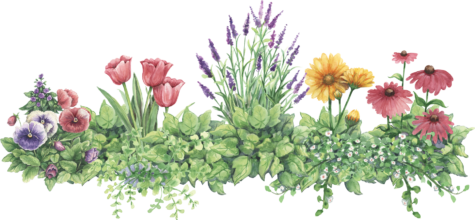 Here is list of herbs associated with luck:
Here is list of herbs associated with luck:
- Alfalfa
- Angel’s turnip
- Ash tree leaves
- Basil
- Blessed thistle
- Chamomile
- Cinnamon
- Clover
- Galangal root
- Grains of paradise
- Mustard seed
- Peony
- Yellow dock
- Wonder of the world root
- Jezebel root
- Mandrake root
- May apple root
- Little John chew
- Lucky hand
- Tonka beans
- Irish moss
- Queen of the meadow root
- Quince seeds
- Parsley
- Five-finger grass
- Swiss leaves
- Silver weed
- Seven barks
- Sacred bark
- John the conqueror root
- Four leaf clover
- Jamaica ginger root
- Rosemary
- Sumbul root
- Ruler: Venus, Celtic goddesses
- Type: Herb
- Magickal Form: Oil, Leaves, Powder
- Latin Name: verbena officinalis
This is one of the most sacred fragrances of the Welsh witches, who wore it or burned it to prepare the way for connection with the God and Goddess. Use Vervain in your protection, love, and immortality spells. Grown on the property, it brings blessings of prosperity to the household.
Take Vervain baths to prolong your life and renew hope. Dust your hands with the powder to make sure the one you love will love you back. When worn, it protects from nightmares and lightning. Use to attract wealth. Vervain is an excellent herb for artists; its use before any creative attempt or performances ensures success.
Burn pure Vervain (or mix with equal parts of frankincense) for a fantastic purification incense.
Great for magickal cleansing baths, purification incenses, and personal safety amulets. Best gathered at Midsummer. Hang up on the bed to keep you free of nightmares. Helps soldiers to escape their enemies. Bury in your fields to make the crops bountiful and profitable. Amulets are sometimes given to babies, for it is said to make its bearer a quick learner. Used in many love and protection sachets.
Juice of the Vervain is believed to suppress sexual desire for long periods of time, and is consumed by religious ascetics to make life a little easier. This same juice, if smeared on the body, will enable a person to see into the future.
Verbena vs Vervain
Vervain (Verbena Officinalis) is a flowering plant in the Verbena (Verbenacea) family of plants. Lemon verbena is actually an entirely different plant. Both Vervain and lemon verbena are in the same plant family, but there are many plants in the Verbena family. Not all are used medicinally in the same ways as Vervain.
Verbena actually means “altar plant” because of the use of bundles of twigs that were tied together and used to sweep altars.
Folk Names
- Juno’s Tears
- Herb of Grace,
- Pigeon’s Grass
- Enchanter’s Plant,
- Simpler’s Joy,
- Holy Herb
- Pigeonwood
- Herb of the Cross
- Verbena
- Herb of Enchantment
- Vervan
- Van Van
More About Vervain
The belief that Vervain is a holy and magickal herb is very old. In Norse mythology, it was sacred to Thor, and in ancient Persia to the sun. The Persians believed that people carrying it would receive friendship and affection from everyone they come across. It was called “tears of Isis” in ancient Egypt, and later called “Hera’s tears”. In ancient Greece it was dedicated to Eos Erigineia.
The Romans believed this herb was sacred to Mars, God of War, and so they also believed that Vervain would repel the enemy. Crowns of the herb were worn by envoys sent to other countries, whether they were there for peaceable purposes or otherwise. The ancient Romans also believed it promoted fertility, and kept it in their homes to ward off evil.
It was venerated by the Druids almost as much as mistletoe and, when gathered under the Dog Star with appropriate rites, was used by them for magickal and healing purposes. Vervain was so sacred to the Druids that anyone who picked one had to immediately place a honeycomb on the spot.
In Christian legend, it is said to have been first found growing under the Cross on Calvary, and to have been used to staunch the bleeding of Our Lord’s wounds. For this reason, it was sometimes called the Holy Herb, and was believed to have the power of averting evil of all kinds, arresting hemorrhage, and healing serious wounds.
It had, however, to be gathered with great care, curing certain phases of the moon and while repeating secret words or incantations. If this was not done, its full strength and virtues were lost. One method of gathering it is described in an Elizabethan manuscript kept in Chetham’s Library in Manchester:
The seeker went to the place where the herb grew and said,
All-hele, thou holy herb,
Vervain,
Growing on the ground;
In the Mount of Calvary,
There wast thou found.
Thou helpest many a grief,
And stanchest many a wound.
In the name of sweet Jesus
I take thee from the ground.
O Lord, effect the same
That I do now go about.
While actually plucking it, he said,
In the name of God,
on Mount Olivet
First I thee found.
In the name of Jesus,
I pull thee from the ground.
Vervain, like St John’s wort and dill, “hindered witches of their will,” and guarded its owner from the effects of overlooking and many other misfortunes. Nevertheless, it was sometimes said to be an “enchanter’s Herb,” and witches, if they were often defeated by it, were also supposed to use it in their spells.
In Hungary, it was beloved of thieves because, like moonwort in England, it has power over locks and bolts. If a man made a small cut in his hand and pressed a fragment of the leaf into it, that hand would afterwards be able to open any locked door or chest lid simply by touching it.
In Hoodoo and other folk magic traditions, Vervain is used to make Van-Van oil – this is simply a blend of Vervain and a base oil, simmered and strained. This oil is used to provide magical protection, and clear away evil energies.
The roots hung about a man’s neck when he went to bed kept away bad dreams, and a tea made from the leaves soothed nervous excitement and prevented insomnia. In the Supplement to the London Pharmocopaeia (1837) it is stated that a necklace of Vervain roots, tied with a yard of white satin ribbon, would help to cure the King’s Evil.
Marcellus of Bordeaux mentions a magickal remedy for a tumor in De Medicamentis (XV). A root of Vervain had to be cut in two, and one half had to be hung round the patient’s neck. The other was smoked in a fire. As it dried in the heat, so would the tumor dry up and vanish. A sinister rider to this receipt says that if it was desired to bring the tumor back again, all that was necessary was to throw the smoked portion into a abasin of water. As it swelled with the moisture,m the tumor would return.
It was also used in love-charms and aphrodisiacs. In Germany, a wreath made from Vervain was often presented to a bride on her wedding day, both to bring her good luck and to ensure the fertility of the marriage. In many forms of folklore, Vervain is associated with workings that decrease lust – however, the scent of Vervain is a well-known aphrodisiac. Another way to tap into the aphrodisiac qualities is to place a few seeds of Vervain into a small bag and wear it around your neck.
In addition to matters of the libido, however, Vervain is commonly incorporated as a cleansing herb. Vervain is the best ingredient to use to wash down an altar or temple before attempting magickal work. It charges the space with power and immediately raises the consciousness of all who enter the space. You can brew up a batch of Vervain water to cleanse your magical tools, asperge around a sacred space, or purify your altar for ritual.
You’ll need:
- 1 / 2 cup fresh Vervain leaves
- 2 cups boiling water
After your water has come to a boil, pour it over the Vervain leaves in a pitcher or bowl. Allow the leaves to steep for half an hour, and then strain. Use a funnel to pour it into a jar. Use the water for cleansing and purification.
Sources:
- Patti Wigington
- Encyclopedia of Magickal Ingredients
- The Encyclopedia of Superstitions
- Magical Herbalism
- Ruler: Mars
- Type: Spice
- Magickal Form: ground, whole
Heat producing and fiery chili pepper makes a great lust ingredient. Add to coconut and chocolate to turn up the flames of desire. Place a circle of red peppercorns around a photograph of your lover to keep others away from him or her.
Pepper is also used for war and separation spells. Sprinkle white pepper in the corners of a room to overcome anger and dissension. Black pepper and peppercorns can hurt others or give protection. Black pepper mixed with salt and sulfur gets rid of someone you don’t want around.
Cayenne pepper makes a good boundary, and can be used to seal a sacred circle protecting those inside the circle from negative or harmful energies.
- See also: Peppercorns and Binding Agreements
One of the oldest and simplest spells in hoodoo is to throw ground black pepper and salt after departing witches or unpleasant people, to prevent them from returning. Sweeping the mixture out after them with a broom makes the trick stronger.
More Pepper Lore
It is bad luck to spill pepper because this will start a fight. The way to remedy this is by putting sugar on the spilled pepper, and leaving it there until it’s cleaned up.
It’s also bad luck to hand pepper to someone. it means you will have an argument with them. Alternatively, if you wish to create problems between a couple, you might be able to organize a situation whereby they hand each other some pepper, in which case, the argument is something you might want.
To prevent something nasty from happening, knock on wood while reciting “peppar, peppar, ta i trä” so they’re not jinxed. It means, “Pepper, pepper, touch wood.”
Sources:
- The Encyclopedia of Magickal Ingredients
- Hoodoo Herb and Root Magic
What follows is a dry and lengthy discussion about peppercorns as legal tender. I included it here at the Magickal Apothecary because it interested me and because I think the concept can be used in magick as well.
Consider this – you want to do magick, and you’d like to invoke the aid of a deity, an elemental spirit, or some magickal entity but you are unsure as to how to “seal the deal.” In a court of law, a “legal” contract, in order to be binding, requires that both sides provide consideration, and I think that in magick this could be true as well.
So, my thought is, that a peppercorn might be offered up when food, or other offerings are inappropriate or inadvisable. A tiny little peppercorn could be left anywhere! I think peppercorns could also be used in binding spells and rituals, as well as other types of magickal agreements.
The Dry and Lengthy Discussion from Wikipedia:
A peppercorn in legal parlance is a metaphor for a very small payment, a nominal consideration, used to satisfy the requirements for the creation of a legal contract. “A peppercorn does not cease to be good consideration if it is established that the promisee does not like pepper and will throw away the corn.” Somervell LJ in Chappell v Nestlé [1960] .
In English law, and other countries with similar common law systems, a legal contract requires that both sides provide consideration. In other words, if an agreement does not specify that each party will give something of value to the other party, then it is not considered a binding contract, and cannot be enforced in court. This requirement does not exist in contracts with civil law systems.
However, courts will not generally inquire into the adequacy or relative value of the consideration provided by each party. So, if a contract calls for one party to give up something of great value, while the other party gives up something of much lesser value, then it will generally still be considered a valid contract, even though the exchange of value greatly favors one side. Courts, however, will reject “consideration” that was not truly bargained for.
For example in the American case Fischer v. Union Trust Co., the Michigan court held that one dollar paid in exchange for the sale of real property did not constitute valuable consideration since the transaction was not bargained for. The dollar is considered nominal consideration, not because the dollar was too small an amount, but because it did not induce the seller to part with the property. Such promises that are motivated by love and affection are insufficient to constitute consideration.
So, in order for an essentially one-sided contract to still be valid and binding, the contract will generally be written so that one side gives up something of value, while the other side gives a token sum such as one pound, one dollar, or—literally—one peppercorn.
Peppercorn payments are sometimes used when a struggling company is sold. A failing company’s net worth may actually be negative, since its liabilities may exceed its assets. So if some other party agrees to take over the company and assume its liabilities as well as its assets, the seller may actually agree to make a large payment to the buyer. But the buyer must still make some payment for the company—even if that payment is only one dollar or one pound—in order to establish that both sides have given consideration.
A peppercorn is also used in more balanced contracts, where one side wishes to conceal the nature of their payment. For example, since real estate contracts are generally matters of public record, the purchaser of a house may not wish to list the exact amount of the payment on the contract. But there must be some specific payment listed in the contract, or the contract will be considered void for lack of consideration. So the contract may be written to reflect that the house is being sold in return for “ten dollars and other good and valuable consideration”. The ten dollars is the “peppercorn” that provides concrete consideration and ensures that the contract is valid, while the actual amount paid for the house is hidden and referred to only as the “good and valuable consideration”.
Another common example of a peppercorn payment being used in legal contracts is the English practice of peppercorn rent, which refers to a nominal rental sum for property, land or buildings. Where a rental contract is put in place and the owner of the property wishes it to be rent free it is normal to charge, say, one pound sterling as a peppercorn rent. Again, this is because, if the owner wants to lease the property, they must charge some rent so that consideration exists for both parties.
Furthermore, a peppercorn rent is often used as a form of nominal ground rent where a (potentially substantial) premium has also been paid on commencement of a long lease of, say, 99 or 125 years (a “virtual freehold”). The notional collection of the annual peppercorn rent helps to maintain a formal Landlord and Tenant relationship between the two parties, precluding the risk of a claim for adverse possession from the tenant arising, were no consideration to be paid for an extended period.
This is a, by no means complete, listing of plants and herbs that come especially under the dominion of the Moon, or are strongly Lunar. Many of these plants are also deeply associated with other planetary influences as well.
- Acanthus – Acanthus mollis
- All-Seed – Atriplex silvestris
- Cabbage (all kinds) – Brassicae
- Cabbage (Lettuce) – Lactuca sativa
- Chickweed – Stellaria media
- Cleavers – Galium aparine
- Cuckoo Flower – Cardamine pratense
- Cucumber – Cucumis sativus
- Daisy – Bellis perennis
- Duckweed – Lenticula palustris
- Galium – Galium aparine
- Goose Grass – Galium aparine
- Gourd – Cucurbita Pepo
- Hawkweed – Hieracium pilosella
- Hyssop – Hyssopus officinalis
- Iris (Florentine) – Iris florentina
- Iris (German) – Iris germanica, dark blue flowers
- Iris (Pale) – Iris pallida, pale blue flowers
- Lady’s Smock – Cardamine pratense
- Lettuce (Cabbage) – Lactuca sativa
- Lily (White) – Lilium album
- Lime Tree – Tilia
- Moneywort – Lysimachia nummularia
- Monk’s Pepper – Agnus castus
- Moonwort – Ruta lunaria
- Mouse Ear – Hieracium pilosella
- Myrtle – Vinca minor
- Notchweed – Atriplex silvestris
- Nutmeg – Myristica fragrans
- Orache – Atriplex silvestris
- Orpine – Sedum telephium
- Papaya – Carica papaya
- Periwinkle – Vinca minor
- Poppy (Corn) – Papa ver rhoeas
- Poppy (Opium) – Papaver somnifrruni
- Privet – Ligustrum vulgare
- Pumpkin – Cucurbita Pepo
- Saxifrage – Saxifraga
- Sedum – Telephium vulgare
- Sharp Stonecrop – Sedum acre
- Speedwell – Veronica officinalis
- Turmeric – Curcuma longa
- Wallflower – Cheiranthus cheiri
- Wall Pepper – Sedum acre
- Water Chestnut – Trapa natans
- Watercress – Nasturtium officinale
- Water Lily – Nymphaea alba
- Willow (all kinds) – Salices
This is a, by no means complete, listing of plants and herbs that come especially under the dominion of the Sun. Many of these plants are also under the dominion of, or are deeply associated with other planets as well.
- Angelica – Angelica archangelica
- Angelica (Wild) – Angelica silvestris
- Ash – Fraxinus excelsior
- Bergamot – Citrus bergamium
- Blueweed – Fchium valgare
- Calamus – Calamus aromaticus (Acorus calamus)
- Chamomile (German) – Matricaria chamomilla
- Celandine – Chelidonium majus
- Cinnamon, Ceylon cinnamon – Cinnamonum ceylanicum
- Cinquefoil – Potentilla reptans
- Clove Tree – Caryophyllus (Syzygium aromaticum)
- Dittany – Dictamnus albus
- Elecampane – mula helenium
- Eyebright – Euphrasia officinalis
- Five Leaf or Finger Grass – Potentilla reptans
- Gentian – Gentiana lutea
- Ginger – Zingiber officinale
- Grape Vine – Vitis vinifrra
- Ground Ivy – Glechoma hederacea
- Juniper – Juniperus communis
- Laurel – Laurus nobilis
- Lemon Balm – Melissa offtcinalis
- Lemon Tree – Citrus limonum
- Lesser Centaury – Erythrea centaurium (Entaurium umbellatum)
- Lingwort – Angelica archangelica
- Marigold – Calendula officinalis
- Marshmallow – Althaea officinalis
- Mistletoe – Viscum album
- Mustard (Black and White) – Sinapis nigra, alba
- Olive Tree – Olea europea
- Orange Tree – Citrus aurantium
- Passionflower – Passiflora incarnata
- Peony – Paeonia officinalis
- Pepper (White and Black) – Piper
- Plantain – Plantago major
- Ribwort – Plantago lanceolata
- Rice – Oryza sativa
- Roman Chamomile – Anthemis nobilis
- Rosemary – Rosmarinus officinalis
- Rue (Common) – Ruta graveolens
- Saint John’s Wort – Hypericum perforaturn
- Scarlet Pimpernel (Common) – Anagallis arvensis
- Sundew – Drosera rotundifrlia
- Sunflower – Helian thus anuus
- Viper’s Buglass – Fchium valgare
- Walnut Tree – Juglans regia
- Wild Strawberry – Fragaria vesca
- Zedoaria, Zedoary – Curcuma zedoaria


